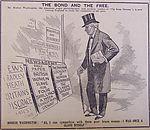 Booker T. Washington cartoon
Booker T. Washington cartoon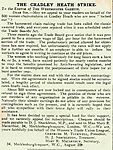 Appeal for donations
Appeal for donations Report of Pathe film
Report of Pathe film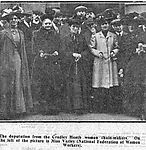 Delegation to T.U.C.
Delegation to T.U.C.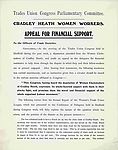 T.U.C. appeal, p1
T.U.C. appeal, p1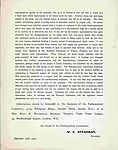 T.U.C. appeal, p2
T.U.C. appeal, p2 Progress on the appeal
Progress on the appeal Contributions from factories
Contributions from factories The Women's prayer
The Women's prayer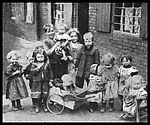 Workers' children
Workers' children

No-one knew when the strike began, where the money would come from to sustain it. The women chainmakers, who were not in a union, could not be paid from the union's strike fund. It was Mary Macarthur, who mounted the publicity campaign, that had the donations flooding in.
Mary arranged interviews with the women, and wrote letters to trade unions and leading newspapers.She spoke at meetings, and used film, produced by Messrs. Pathe, to illustrate the terrible conditions of the women chainmakers. The films were shown across London, and in five to six hundred picture theatres around the country. It was estimated that in two weeks over ten million people had seen it.
Local and national newspapers carried stories of the strike. Reynold's News immortalized the women as "The White Slaves of England". It also ran a cartoon of Booker T. Washington, a freed slave and founder of the first university for black students, shown sympathising with the chainmakers, saying, "I was once a slave myself."
Investigators came from Germany, Australia and America to see the conditions for themselves. When Will Anderson, Chairman of the Independent Labour Party, attended an international conference in Copenhagen, he found that the Cradley Heath strike was the main topic of conversation.
The strikers had the support of the trade unions. A delegation had gone to the Trade Union Congress (T.U.C.) in Sheffield. After seeing them, and hearing what they had to say, the T.U.C. promised its full support. The circular it sent to all its trade unions is shown above.
They found support among the aristocracy, businessmen, churchmen, politicians and workers. Donations poured in, in money and in kind. Gifts included a collection of old-fashioned jewellery, lace goods from a lacemaker in Ireland, a van load of bread and two hams for a tea for the women.
Even Cradley Heath's children seemed to enter into the spirit of the time. They greeted visitors to Cradley with a request for a nod of the head. For each one they marked a cross on a piece of paper. When they had a hundred, they buried the paper for two days, dug it up, soaked it in water for a day, and then burnt it on the forge. While it was burning, they made a wish. Perhaps they wished for more money in their mothers' pockets.
Mary Macarthur had hoped for £1,000 pounds. By the end of the strike they had raised a sum close to £4,000. A successful end to the strike left a large surplus in the strike fund. Most of the money was used to build the Cradley Heath Workers' Institute. The building, which has been reconstructed at the museum, is a lasting monument to the courage and determination of the Cradley Heath women chainmakers, and all those who supported them.
Rollover the captions in the box to see the available images in thumbnail format, click the caption to see the full-size image
| Reference: | 729 |
| Keywords: | |
| Archive Ref: | |
| Updated: | Tue 17 Jul 2007 - 1 |
| Interpretation written by | Barbara Harris |
| Author's organisation | |
| Organisation's website |